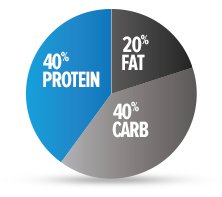
Campus Nutrition: A Food Guide For Busy Students
When you're a busy student on a tight budget, eating right can seem like an impossible task. Get through the school year and into a stronger, healthier, and better-looking body!

School is back in session! Are you pumped or petrified? If you're pumped, you're probably excited to be back with your friends, hanging out in your school gym, and challenging your brain. But you could also be dreading a new schedule, falling into poor habits, or blowing your diet plan. Excessive pizza and beer sound familiar?
We all know lean bodies are carved in the kitchen, but what happens when you're a busy student on a budget? Juggling school, work, friends, training, and nutrition can suffocate you in stress. You might feel that you can't possibly do it all. I'm here to assure you that you can!
The following is a school-friendly nutrition curriculum. I want to provide you with ideas for healthy options and tools that will allow you to get the nutrition you need at a price you can afford. It's simple, basic, and workable for anyone with fat-loss or muscle-building goals. Let's dive in!
Set A Goal
Don't be overzealous and set unobtainable goals. If you do, you will inevitably set yourself up for failure. Yes, you want to be ambitious, but at the same time you need to be honest with yourself. Understand your possibilities and limits, set goals that are ambitious yet reasonable, and then fervently pursue them.
Effective goals are measureable and should come with a time limit. A good example would be something like: "Stick to diet plan five days per week for the entire fall semester." Or, "Lose 10 pounds by the new year." Your goal should be strong enough to motivate you through the tough work ahead.

Determine Caloric Requirements
One of the biggest obstacles when piloting a meal plan is trying to figure out how many calories you need. The following methodology isn't perfect, but it is a great way to estimate your approximate caloric requirements. First, determine if you're an ectomorph, mesomorph, or endomorph. Here's a pretty good calculator.
Next, use the following calculation to acquire your daily caloric intake requirements:
Men
- If you're an ectomorph, multiply your bodyweight by 16.5
- If you're a mesomorph, multiply your bodyweight by 15
- If you're an endomorph, multiply your bodyweight by 13.5
Women
- If you're an ectomorph, multiply your bodyweight by 13.5
- If you're a mesomorph, multiply your bodyweight by 12
- If you're an endomorph, multiply your bodyweight by 10
This calculation gives your approximate daily caloric intake. If your goal is to gain mass then you should add about 500 total calories per day. If your goal is to lose body fat, subtract 500 total calories per day.
The surplus or deficit of 500 calories should come from carbs. One carb gram equals four calories, so you'll be adding or subtracting 125 carb grams. This is a basic approach, but should suffice for our purposes.

Macros and Timing
Next, we need to address your macronutrient allotment. Everyone follows a different ratio, but what worked best for me was eating 40 percent of my calories from carbohydrates, 40 percent from protein, and 20 percent from fat.
Last, we need to determine how often to eat. This is another heavily debated and contentious topic. Personally, I prefer somewhere between 4-7 meals per day to make sure that I meet my daily macronutrient and caloric requirements. So choose a number that works best for your goals and with your schedule. Aside from fueling your workouts, meal timing works differently for each person, so don't freak out if you miss a meal.
Planning for Success
If you're in high school or a freshman attending college, then you are most likely on a "meal plan" provided by your school. Since you pay for it, make the most of it! Yes, the stereotype of unhealthy cafeteria food is partially true, but that doesn't mean it doesn't have foods that will fit into your diet. Surprisingly, cafeterias offer variety and often are willing to meet your requests or answer questions you have about the food's ingredients, nutritional value, substitutions, etc. If you have dietary restrictions, let them know. You can also get certain meals without sauces, ask for sauces on the side, or make special requests—you'll never know unless you ask! You'd be surprised how flexible the cooks can be.
If you have difficulty finding healthy options, stick to the salad bar for fruit, vegetables, nuts, and legumes. The salad bar should also offer protein sources including turkey, chicken, eggs, low-fat cheese, yogurt, and tuna. If you find there are more carbohydrate options than anything, then revolve your cafeteria visits around your workouts. Eat at the cafeteria before and after your workout so you fuel and refuel.
When you're not in the cafeteria, surround yourself with healthy choices. If you have it in your budget, try to stock up on protein bars and protein powder. Canned vegetables and canned chicken or tuna are perfect on-the-go meals. It's also smart to have low-fat yogurts, cottage cheese, dehydrated veggies and fruits, nuts, and hard-boiled eggs. These foods are all great, healthy, and portable. They'll make it easy to hit your macronutrient and caloric requirements, even in class.

Execute
The last piece to this puzzle is to put your plan into action. You know how many calories you need, and what macronutrient ratio you're shooting for, and you planned out your meals. If you're serious about building or maintaining your hard body, don't let your schedule get in your way.
You will encounter difficulty, hardship, and doubt. But with persistence, optimism, and hard work, you can reach and even exceed your fitness goals while you're at school. Follow the basic steps outlined in this article and avidly stick to your nutrition plan; you'll find your goals are not so far off! If you have any questions or need support, reach out to me on BodySpace or leave a comment below.

School Nutrition Tips